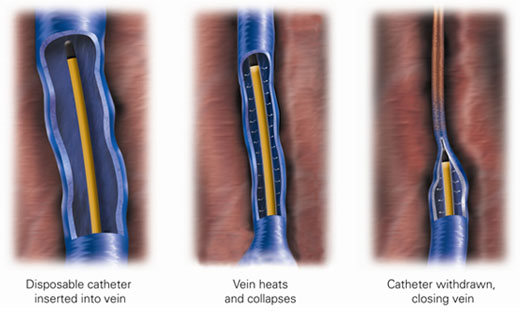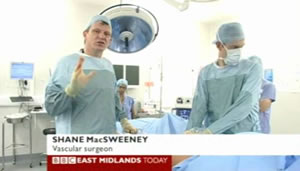VNUS Catheter Ablation
Newer Less Invasive Methods of treating varicose veins;
VNUS Closure and EVLT (Laser Surgery)
The vein which runs down the inside of the leg from the groin to the ankle (long saphenous vein) is the commonest vein to allow blood to flow in the wrong direction and to need treatment (see "varicose veins" for an explanation).

Traditional surgery involves making a cut in the groin to tie this off and then removing it ("stripping"). While this is effective, it requires a general anaesthetic and produces a significant amount of bruising which takes time to recover from.
Newer treatments aim to deal with this vein in a much less invasive way so as to avoid a cut and often the need for a general anaesthetic, they also produce much less pain and bruising, so that recovery is faster.
There are two basic non-invasive ways of dealing with the vein, either by feeding a very fine device up within the vein from below and using it to heat up the vein from the inside (VNUS catheter ablation or Endovenous Laser therapy) or by injecting foam into the vein (foam sclerotherapy).
What is VNUS CLOSUREFAST? (Radiofrequency ablation)
See Mr MacSweeney doing a local anaesthetic VNUS procedure on BBC News.
Closurefast procedure animation video
Download a PDF of the patients guide to VNUS Closure.
The usual vein that needs to be treated is the vein that starts in the groin and runs down the inside of a leg to the ankle. The traditional method is to make a cut in the groin, tie the vein off, and strip the vein out. This involves incisions under general anaesthetic, works perfectly well but causes quite a lot of bruising and discomfort afterwards. VNUS closurefast is a less invasive way of doing the same thing. It works by heating up the inside of the vein, this causes it to shrivel up and effectively does the same as stripping it but without the cuts or the bruising and with a much better recovery.
How is it done? (You may find looking at the diagram above or video clip helpful.
It can be done under general or a local anaesthetic and the local anaesthetic is described here. The vein to be treated is marked before the procedure and some local anaesthetic jelly is applied along the length of the vein to the skin. The leg is then cleaned up with antiseptic solution and you will lie down on a sterile operating table. Everything will be cleaned and prepared as for an ordinary operation. The first part of the procedure is that a small tube is inserted into the vein usually just below the knee. The catheter which is used to do the procedure is then passed through the tube, up the inside of the vein, as far as the groin. An ultrasound scanner is used to check the position to make sure the whole length of the vein is treated but that no areas of vein that do not need treatment are affected. The next stage of the procedure is to insert lots of local anaesthetic all around the vein. This is the part of the procedure that usually takes the longest, and may be slightly uncomfortable because a needle is used to insert the fluid around the vein, the local anaesthetic jelly will usually take the edge off this but does not always stop it completely.
Once all the local anaesthetic is inserted and the scan shows that everything is positioned correctly, the treatment will start. You will hear a beeping noise coming from the generator and this indicates the catheter is being heated up and it is this that shrivels the vein away. Most of the time people do not notice anything when the treatment starts and are often quite surprised when you tell them that the treatment has begun, but occasionally people notice a slight discomfort when this occurs. If it is uncomfortable, let the surgeon know and he will stop the treatment and put a bit more local anaesthetic around it if necessary. The vein is treated one segment at a time, the catheter being withdrawn in stages as each section of the vein is treated. When the segment to be treated is complete, the catheter is removed. Sometimes some small nicks are made over branches arising from the main vein again under local anaesthetic and these are removed as well. If you have just had the VNUS catheter a full length stocking will be put on your leg, with a bandage at the site where the catheter was inserted. If you have had branches of the vein removed as well then the whole leg will be bandaged up.
You are normally able to get up and walk off the operating table and go home shortly afterwards.
What do I do after the operation?
If you have had VNUS Closure fast only:
You will have a full length support stocking with a bandage over the place where the catheter was put in (usually just below the knee). If all you have is the vnus closurefast treatment then there will be no incision as such, just a small mark where the catheter was inserted. Usually people have very little pain after the operation. However, you may notice that there is slight discomfort when the local anaesthetic wears off and if so take painkillers such as Ibuprofen (e.g. nurofen) and paracetamol, the combination works well. You are free to do whatever you feel comfortable with following the procedure, but it would seem sensible to take it reasonably gently at least for the rest of the day and overnight. You may notice some tenderness in the inner thigh where the vein has been treated even though there is not much to see.
The next day you can walk about as much as you feel confortable with. There is a a bandage over the stocking at the site the catheter was put in, this can be removed. If you are sitting down try and put the leg up. If you want a shower you can have one. As soon as you can move your leg easily enough to change gear/do an emergency stop as normal you can start driving again. Usually OK day after operation, but give it more time if you feel you need it. (if you have had a general anaesthetic give it 24 hours minimum).
Exercise
Do what you feel comfortable with, I would build up slowly and go easy on high impact e.g. running for the first few days. You will not do yourself any harm but it may be uncomfortable. I would suggest you wear the stocking day and night for two weeks (except when showering) but if you are fed up with it you can take it off sooner.
Work
Obviously it depends on how active your job is but usually people are able to go back after a few days although it will take a longer than that before your leg feels normal. If possible I would suggest arrange to do some work at home and go back after a week. What I would try to avoid is making work commitments you feel you have to keep and then not feeling up to them.
I normally arrange a follow up appointment about six weeks after the procedure to check all is OK.
If you have had removal of branch veins through little incisions as well (multiple avulsions).
This is a very variable group, which ranges from people with a few small nicks in one leg to others who have had veins the size of hosepipes removed from both legs. Obviously despite making every effort to keep any bruising to a minimum you are likely to have more if you have had lots of big veins removed than if you have had a few small ones.
You will have your leg(s) wrapped up in a bandage (this applies more pressure than a stocking and helps minimise any bruising). You should keep this on for 48 hours (you can keep it on for longer if you wish). The bandage has a short sticky bit at the top to stop it falling down; below this is a stocking so that it does not stick to the skin. Most people arrange to go to their GP surgery to have the bandage taken off but if you prefer you can do it yourself. You just need some heavy scissors. If you do pull off a scab when taking the bandage off then just put the leg up and a Band-Aid on it and press for a few minutes. There are no stiches to remove. You will have been given a stocking to wear from the hospital and most people find wearing a stocking is confortable and gives some support. You should wear it for about two weeks but it is for your comfort so you do not have to wear it. The small incisions do not need to be covered up but do put a sticking plaster on if you wish to. You can have a gentle shower once the bandages are removed.
As far as pain killers and activity / driving is concerned (see above). I would suggest you take things pretty easy for the first couple of days while the bandages are on. It is likely to take longer for everything to settle down than if you have just vnus without avulsions, particularly if both legs have been treated in one go. Again be guided by what feels comfortable, if you overdo it you are likely to find it uncomfortable rather than do any harm. You will probably want to take a week off work and wait till the bandages are off before driving. The sites of avulsions often feel a bit firm to start with; they do soften after a while (weeks). The cuts are quite small but to start with they are quite dark which contrasts if you have got pale skin. As time goes by they will fade and eventually although they will still be there they will be difficult to see except from very close up. You may have some bruising and this will fade away as time goes by.
We will arrange to see you for a check up at about six weeks after your operation.
 Contact Me
Contact Me See Mr MacSweeney doing a local anaesthetic VNUS procedure on BBC News.
See Mr MacSweeney doing a local anaesthetic VNUS procedure on BBC News.